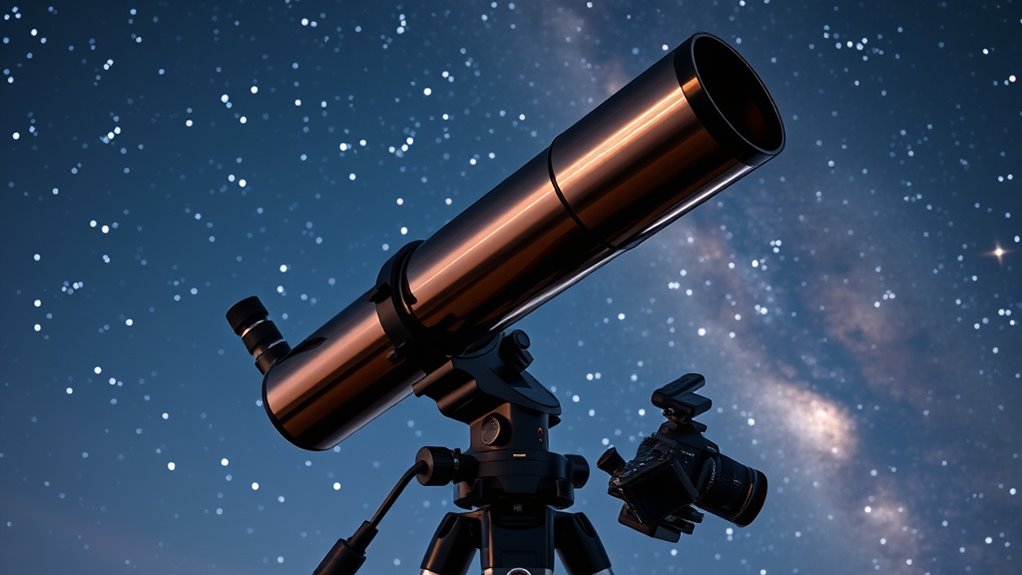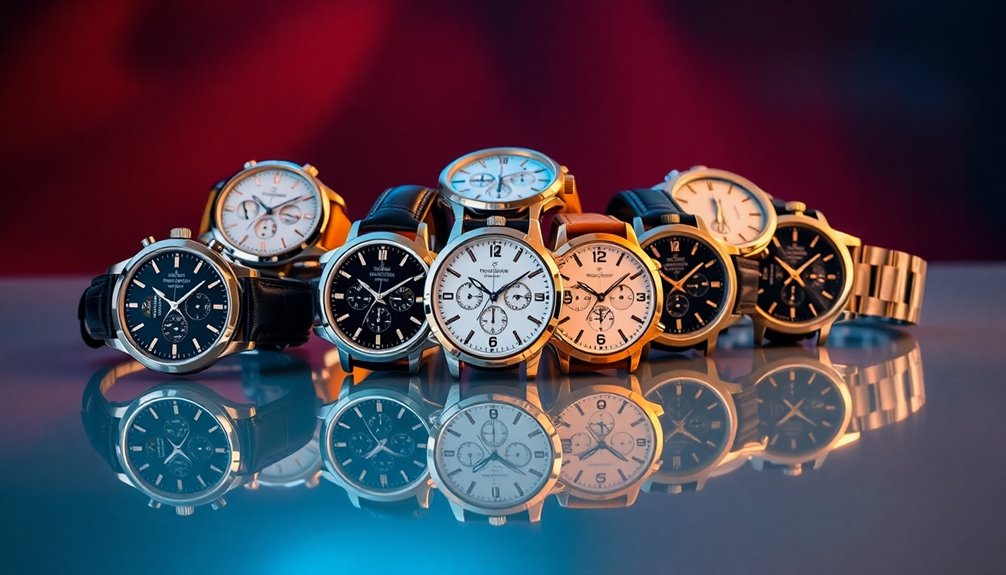If you’re after the best 130mm triplet APO refractors for astrophotography in 2025, I recommend considering models with high-quality FCD1 or FCD100 ED glass, air-spaced triplet design, and multi-layer coatings for sharp, contrast-rich images. Look for lightweight, durable builds with precise focusers and versatile mounts. These telescopes excel at capturing detailed images of planets, nebulae, and galaxies. Keep exploring as I reveal the top choices that fit these criteria and more.
Key Takeaways
- Look for models with high-quality FCD1 ED glass and air-spaced triplet design for minimal chromatic aberration and sharp images.
- Prioritize refractors offering focal lengths around 900mm to 950mm and f/6 to f/7.5 ratios for versatile astrophotography.
- Choose lightweight, durable aluminum models with stable mounts and precise focusers for ease of field setup.
- Consider compatibility with various camera adapters, filters, and mount types like Vixen-style dovetails for flexible imaging.
- Review top-rated options known for optical performance, portability, and accessories suitable for planetary and deep-sky astrophotography in 2025.
Explore Scientific ED102 Refractor Telescope for Astrophotography
If you’re looking for a versatile and high-performance refractor for astrophotography, the Explore Scientific ED102 stands out as an excellent choice. With its 102mm aperture, 714mm focal length, and f/7 ratio, it captures crisp, detailed images of stars, nebulas, and planets. The apochromatic design uses genuine FCD1 HOYA ED glass and multi-layer coatings, virtually eliminating chromatic aberration. Its portable build—with a retractable dew shield and handle—makes it ideal for travel. Users praise its sharp edge-to-edge star images and ease of use, making it a top pick for both beginners and experienced astrophotographers seeking a reliable, high-quality refractor.
Best For: amateur astronomers and astrophotographers seeking a portable, high-quality refractor capable of detailed deep-sky and planetary imaging.
Pros:
- Exceptional optical quality with sharp, edge-to-edge star images and minimal chromatic aberration
- Lightweight and portable design, ideal for travel and field use
- Comes with essential accessories like diagonal, T-adapter, T-ring, and moon filter, providing good value
Cons:
- Focuser may have some initial slop or backlash requiring adjustment
- Mounting screws can need minor tuning to prevent star shape distortions
- Some accessories need to be purchased separately, adding to initial setup costs
Explore Scientific ED80 Refractor Telescope for Astrophotography
The Explore Scientific ED80 Refractor Telescope stands out as an excellent choice for amateur astrophotographers who prioritize high optical quality in a portable package. Its genuine FCD1 HOYA ED glass and multi-layer coatings deliver sharp, high-contrast images with minimal chromatic aberration, ideal for capturing the Moon, planets, and deep-sky objects. The compact 80mm triplet design makes it lightweight and easy to transport, perfect for spontaneous sessions. While mounting can require some modifications, its excellent optics and user-friendly features make it a versatile, reliable tool for both visual observing and astrophotography, especially when paired with suitable accessories.
Best For: amateur astrophotographers seeking a high-quality, portable refractor telescope with excellent optical performance for capturing detailed celestial images.
Pros:
- High-contrast, sharp images thanks to genuine FCD1 HOYA ED glass and multi-layer coatings
- Virtually eliminates chromatic aberration with air-spaced triplet design
- Compact, lightweight, and portable, ideal for spontaneous observations and quick setups
Cons:
- Mounting can require modifications for stability, such as adding rubber pads or switching screws
- Proprietary finder scope mount may need adapters or specific rings for certain accessories
- Some users report minor manufacturing defects and initial setup challenges
Explore Scientific FCD100 Series 80mm Air-Spaced Apochromatic Triplet Refractor Telescope
For astrophotographers seeking a compact yet high-performance telescope, the Explore Scientific FCD100 Series 80mm Air-Spaced Apochromatic Triplet Refractor stands out due to its exceptional optical quality. It uses genuine Hoya FCD100 ED glass and multi-layer coatings, delivering high-contrast, detailed images with minimal chromatic aberration. Its air-spaced triplet design guarantees sharp, clear views of the Moon, planets, nebulae, and galaxies. With a focal length of 480mm and an f/6 ratio, it gathers ample light while remaining portable. Features like the hybrid finder scope base, Vixen-style dovetail, and a high-quality 2.5-inch focuser make setup easy and versatile.
Best For: astrophotographers and amateur astronomers seeking a high-quality, portable refractor telescope for detailed imaging of celestial objects.
Pros:
- Exceptional optical quality with genuine Hoya FCD100 ED glass and multi-layer coatings for high contrast and minimal chromatic aberration
- Compact and lightweight design ideal for portability and spontaneous stargazing
- Versatile features including hybrid finder scope base, Vixen-style dovetail, and a high-quality 2.5-inch focuser for easy setup and precise focusing
Cons:
- Premium price point may be a barrier for beginners or budget-conscious users
- Limited aperture size (80mm) may not gather as much light as larger telescopes for deep-sky astrophotography
- Requires additional accessories (e.g., mount, camera adapters) for complete astrophotography setup
Celestron StarSense Explorer DX 130AZ Telescope
Designed with beginners in mind, the Celestron StarSense Explorer DX 130AZ combines user-friendly smartphone integration with powerful optical performance, making it an ideal choice for those stepping into astrophotography. Its 130mm Newtonian reflector offers sharp views of the Moon, planets, nebulae, and galaxies, thanks to high-reflectivity coatings. The manual altazimuth mount with dual-axis slow-motion controls makes target tracking straightforward. Using StarSense technology, the telescope analyzes star patterns to pinpoint its position and guides you via a smartphone app. Setup is simple, and the app’s guidance guarantees smooth object acquisition, making celestial observation accessible and rewarding even from light-polluted areas.
Best For: beginners and amateur astronomers seeking an easy-to-use, app-guided telescope with solid optical performance for viewing the Moon, planets, and deep-sky objects.
Pros:
- User-friendly smartphone app with star recognition technology simplifies targeting and navigation.
- High-quality 130mm Newtonian reflector provides bright, sharp images of celestial objects.
- Easy setup with a manual altazimuth mount and dual-axis slow-motion controls for smooth tracking.
Cons:
- Manual tracking may require adjustments during extended viewing sessions.
- App reliance means performance can be affected by smartphone compatibility or technical issues.
- Not ideal for advanced astrophotography or long-exposure imaging due to its beginner-oriented features.
Explore Scientific FCD100 ED102 Refractor Telescope (OTA Only)
If you’re serious about astrophotography and need a high-quality refractor, the Explore Scientific FCD100 ED102 is an excellent choice thanks to its advanced optical design. Its genuine HOYA FCD100 ED glass offers exceptional image clarity, while proprietary EMD multi-layer coatings maximize light transmission and minimize reflections. The 102mm aperture and f/7 focal ratio deliver sharp, color-accurate images with a resolution of 1.14 arcseconds. Built with durable yet lightweight aluminum, it weighs just under 11 pounds, making it easy to handle and integrate into your setup. Designed as an OTA only, it’s perfect for those seeking a premium, modular astrophotography instrument.
Best For: Serious amateur astronomers and astrophotographers seeking a high-quality, lightweight refractor for detailed imaging and observation.
Pros:
- Exceptional image clarity thanks to genuine HOYA FCD100 ED glass and advanced optical coatings
- Lightweight and durable aluminum construction facilitates easy handling and setup
- High resolution of 1.14 arcseconds ensures sharp, color-accurate images
Cons:
- OTA-only design requires additional mounting and accessories for complete setup
- Slightly heavier than some portable refractors at 10.9 lbs, which may impact portability for some users
- Premium optical features come at a higher price point, potentially limiting accessibility for beginners
SVBONY SV105 Telescope Camera for Astrophotography
The SVBONY SV105 Telescope Camera stands out as an excellent choice for amateur astronomers enthusiastic to dip into astrophotography without breaking the bank. It features a 1/2.8 IMX307 CMOS sensor, capturing up to 30 frames per second at 1920×1080 resolution, supporting 2K video recording. Designed for lunar, planetary, and terrestrial imaging, it’s compatible with standard 1.25-inch filters and connects directly to telescopes. Its plug-and-play operation requires no driver installation, making setup quick and straightforward. Many users praise its affordability, ease of use, and decent image quality, making it a popular entry-level option for beginners exploring astrophotography.
Best For: amateur astronomers and beginners looking for an affordable, easy-to-use camera for lunar, planetary, and terrestrial astrophotography.
Pros:
- Plug-and-play setup with no driver installation required.
- Supports high-quality 1080p video recording at 30 fps.
- Compatible with standard telescope filters and various operating systems, including Windows, Linux, and Android.
Cons:
- Limited resolution compared to higher-end astrophotography cameras.
- Potential issues with overheating or hardware recognition on some systems.
- Not suitable for deep-sky imaging or advanced astrophotography needs.
Celestron Omni XLT 120 Refractor Telescope
For amateur astronomers seeking a reliable and high-quality refractor for planetary and lunar observation, the Celestron Omni XLT 120 Refractor Telescope stands out. Its hand-figured optics with StarBright XLT coatings deliver bright, sharp images, especially with high-end eyepieces. The sturdy German equatorial CG-4 mount provides smooth tracking, making it excellent for detailed planetary and lunar views. While its small 120mm aperture limits deep-sky imaging, it’s portable, easy to set up, and upgradeable with tracking and astrophotography accessories. The included accessories, like the 25mm eyepiece and finderscope, make initial observations straightforward, though some users find the scope’s length and weight challenging for overhead viewing.
Best For: amateur astronomers interested in high-quality planetary and lunar observation with a reliable refractor telescope.
Pros:
- Bright, sharp images with hand-figured optics and StarBright XLT coatings
- Smooth tracking and stable observations thanks to the German equatorial CG-4 mount with worm gear slow-motion controls
- Portable and easy to set up, with upgrade options for tracking and astrophotography
Cons:
- Small 120mm aperture limits deep-sky object viewing, especially faint galaxies
- Length and weight of the telescope can make overhead viewing awkward and transport cumbersome
- Included finderscope may be difficult to use, often recommended for upgrading or replacement
SVBONY SV550 Telescope with Field Flattener Bundle
Designed for astrophotographers seeking high-quality images, the SVBONY SV550 Telescope with Field Flattener Bundle offers outstanding optical performance in a lightweight package. Its 80mm F6 APO triplet delivers sharp, color-free images, while the included 1.0X field flattener guarantees a flat field for both half-frame and full-frame cameras. Constructed with light suppression features and a magnesium alloy focusing seat, it minimizes stray light and reduces weight for easier handling. The stable 180mm dovetail plate supports diverse accessories, making it ideal for deep-sky astrophotography. Overall, this bundle combines portability, precision, and versatility for stunning astrophotos.
Best For: amateur and professional astrophotographers seeking a portable, high-precision telescope with excellent image correction capabilities for deep-sky imaging.
Pros:
- High-quality 80mm F6 APO triplet lens provides sharp, color-free images.
- Built-in 1.0X field flattener supports both half-frame and full-frame camera imaging for versatile astrophotography.
- Lightweight magnesium alloy focusing seat and stable 180mm dovetail plate enhance portability and mechanical stability.
Cons:
- The advanced light suppression features may require careful handling during setup.
- The telescope’s lightweight design might be less suitable for extremely heavy accessories without additional support.
- As a specialized astrophotography instrument, it may have a steep learning curve for beginners unfamiliar with optical adjustments.
Askar 120APO Telescope for Astrophotography and Viewing
If you’re serious about astrophotography and want a compact yet high-quality refractor, the Askar 120APO offers an excellent balance of performance and portability. Its 120mm aperture and F7 focal ratio deliver sharp, color-corrected images thanks to the triplet air-spaced APO design with ED glass. With a length of just 722mm (dew shield retracted) and weighing 6.5kg, it’s easy to transport and set up. The sturdy build ensures stability during observations, while the included accessories support both imaging and visual use. Overall, the Askar 120APO is a versatile choice for astrophotographers seeking quality in a portable package.
Best For: amateur astronomers and astrophotographers seeking a portable, high-quality refractor for detailed imaging and viewing.
Pros:
- High optical quality with triplet air-spaced APO design and ED glass for sharp, color-corrected images
- Compact and lightweight (6.5kg, 722mm length) for easy transport and setup
- Includes essential accessories such as tube rings, dovetail plate, handle, and carrying case for versatile use
Cons:
- Limited to 120mm aperture, which may not be sufficient for very deep-sky objects requiring larger scopes
- Requires additional mounting hardware for specific setups or heavier accessories
- May have a higher price point compared to entry-level refractors of similar size
Explore Scientific FCD100 Series 127mm Refractor Telescope
The Explore Scientific FCD100 Series 127mm Refractor Telescope stands out with its high-quality triplet ED apochromatic lens, making it an excellent choice for serious astrophotographers seeking sharp, color-free images. It features a 127mm aperture, 952mm focal length, and f/7.5 focal ratio, along with a 2.5 HEX focuser. Weighing 14 pounds, it’s relatively portable for its size. The optics are designed to minimize chromatic aberration, delivering crisp details. However, some users find the focuser and diagonal could be better, and customer reviews highlight concerns about value and build quality. Despite its specs, support and pricing remain points to contemplate.
Best For: Serious astrophotographers and amateur astronomers seeking high-quality, color-free images with a portable yet powerful refractor telescope.
Pros:
- High-quality triplet ED apochromatic lens minimizes chromatic aberration for sharp images
- Compact and portable design weighing only 14 pounds with a 127mm aperture
- Excellent optical specifications with a 952mm focal length and F/7.5 focal ratio
Cons:
- Customer reviews indicate concerns about build quality and focusers, especially at this price point
- Poor customer service and warranty support reported by multiple users
- Higher price compared to similar telescopes offering better value from competitors like Tele Vue and Stellarvue
Factors to Consider When Choosing 130MM Triplet APO Refractors for Astrophotography

When selecting a 130mm triplet APO refractor for astrophotography, I focus on several key factors that impact performance and usability. These include optical quality, focal length and ratio, build stability, portability, and compatibility with accessories. Understanding these points helps me choose a scope that meets my imaging needs and offers long-term satisfaction.
Optical Quality and Glass
Choosing a high-quality 130mm triplet APO refractor hinges on its optical glass and design, as these determine the clarity and accuracy of your astrophotos. Genuine FCD1 or FCD100 ED glass in triplet designs offers superior chromatic aberration correction, resulting in sharp, high-contrast images. Multi-layer coatings on all optical surfaces maximize light transmission and minimize reflections, boosting image brightness and clarity. The air-spaced triplet setup virtually eliminates chromatic aberration, ensuring accurate color reproduction across the spectrum. High-quality ED glass elements also reduce false color, enabling detailed imaging of planets, nebulae, and deep-sky objects. Optical quality is often gauged by resolution and contrast, with premium triplet APOs reaching near or below 1 arcsecond, ideal for precise astrophotography.
Focal Length and Ratio
Focal length and ratio directly impact your astrophotography results by determining the field of view, magnification, and image brightness. A 130mm triplet APO typically has a focal length ranging from 480mm to 952mm, influencing how much of the sky you can capture and the level of detail. Shorter focal ratios like f/6 provide wider fields, ideal for large nebulas and star clusters, while longer ratios such as f/7.5 offer higher magnification for planetary detail. The focal ratio also affects exposure times, with lower ratios requiring shorter exposures. If you’re aiming for wide-field astrophotography, a shorter focal length and ratio are advantageous. Conversely, high-magnification imaging benefits from longer focal lengths, making your choice essential based on your target objects and imaging style.
Mechanical Stability and Build
A stable and rigid mechanical build is vital for achieving sharp, consistent astrophotography images with a 130mm triplet APO refractor. It minimizes vibrations and flexure during long exposures, preventing image blurring. A quality mount and dovetail connection keep the optical tube properly aligned, reducing unwanted movement. The focuser should operate smoothly, with minimal backlash, and allow enough tension adjustment to stay locked in focus without slipping. Using durable construction materials like aluminum or magnesium alloys helps maintain structural integrity while keeping weight manageable. Secure fastening points and minimal play in locking screws are essential to prevent shifts in optical alignment over time. Overall, a well-built, sturdy telescope ensures that your images remain sharp and stable, even during extended astrophotography sessions.
Portability and Weight
Since portability directly influences how easily I can transport and set up my astrophotography gear, it’s vital to take into account both the weight and size of a 130mm triplet APO refractor. These telescopes typically weigh between 10 to 15 pounds, striking a good balance between optical quality and portability. Lighter models often use aluminum or magnesium alloys, reducing weight without sacrificing durability. The size and weight affect how easily I can carry the scope and set it up in the field, making lighter options more convenient for travel. Heavier telescopes may need sturdier mounts and tripods, adding complexity. Overall, considering both weight and dimensions helps guarantee quick setup, efficient transport, and minimal fatigue during long astrophotography sessions.
Accessories and Compatibility
Choosing the right accessories and guaranteeing compatibility are key steps when selecting a 130mm triplet APO refractor for astrophotography. First, verify the mounting options—Vixen-style or M48 mounts—to support various cameras and accessories. The focuser should support high-precision, dual-speed, or 10:1 ratio mechanisms, which are crucial for fine focus adjustments. Check if the telescope includes extension tubes or back-focus spacers, helping you achieve ideal distances for your camera sensors. Also, guarantee it has secure connection interfaces for field flatteners, reducers, and adapters, maintaining stability during imaging sessions. Lastly, confirm the presence of standard threaded ports, such as 2-inch or 1.25-inch, to easily attach filters, diagonals, and other imaging accessories. Compatibility is essential for a smooth astrophotography experience.
Price and Value
When evaluating 130mm triplet APO refractors for astrophotography, price often reflects a combination of optical quality, build materials, and included features. Higher-priced models tend to offer better optics, but the value may not always justify the cost compared to mid-range options. Budget-friendly scopes can perform well for beginners, though they might lack advanced coatings or premium features found in pricier models. Keep in mind, accessories like mounts, adapters, and filters add to the overall setup cost and influence value. It’s essential to compare features and reviews, as market fluctuations and brand reputation impact prices. Ultimately, investing in a scope that offers noticeable performance improvements ensures your money is well spent, balancing quality and affordability.
Frequently Asked Questions
How Does Aperture Size Impact Astrophotography Quality in 130MM Triplet APOS?
Aperture size directly affects astrophotography quality because it determines how much light the telescope gathers. With a 130mm triplet APO, I find it captures enough light to reveal faint celestial details while minimizing chromatic aberration. A larger aperture improves resolution and detail, but it’s crucial to balance size with portability and mount stability. Overall, a 130mm aperture offers a great mix of brightness, clarity, and manageable size for astrophotography.
What Are the Best Accessories for Optimizing 130MM Triplet APO Performance?
If you want to open your 130mm triplet apo’s full potential, invest in high-quality accessories. I recommend a precise star diagonal, a reliable field flattener, and a sturdy mount with good tracking. Don’t forget a good auto-guider and a robust camera adapter. These tools transform your setup, ensuring sharper images and smoother sessions. Trust me, the right gear makes all the difference in capturing stunning celestial shots.
How Does Chromatic Aberration Vary Among Different 130MM Triplet APO Models?
Chromatic aberration varies quite a bit among different 130mm triplet APO models. I’ve noticed that premium models with ED or fluorite elements tend to have minimal color fringing, making them ideal for astrophotography. Budget-friendly options might show more chromatic aberration, especially around bright stars and planets. Overall, I recommend choosing a high-quality triplet with ED glass to keep color distortions to a minimum and get sharper images.
What Maintenance Is Required for Long-Term Durability of These Telescopes?
Think of your telescope as a delicate garden that needs tending. I regularly clean the lenses with a gentle blower and lens wipes, check for any signs of mold or dust, and keep it in a dry, stable environment. I also protect it from sudden temperature changes and handle it carefully during transport. Proper maintenance guarantees my refractor remains sharp and vibrant, ready to reveal the universe’s secrets for years to come.
Are 130MM Triplet APOS Suitable for Planetary Versus Deep-Sky Imaging?
Absolutely, a 130mm triplet APO refractor is great for planetary imaging because of its sharp, high-contrast views that reveal fine details. For deep-sky objects, it performs well too, especially when paired with the right camera and mount. While it’s more optimized for planets and the moon, it can still capture beautiful images of galaxies and nebulae, making it a versatile choice for both planetary and deep-sky astrophotography.
Conclusion
Choosing the right 130mm triplet apo refractor feels like balancing a delicate lens and capturing the universe’s vastness. Whether I’m gazing at distant galaxies or framing crisp astrophotos, each telescope offers a unique window into the cosmos. It’s like holding a tiny universe in my hands—both fragile and infinite. Whichever you pick, remember that your journey into the stars is as much about discovery as it is about the equipment.




















